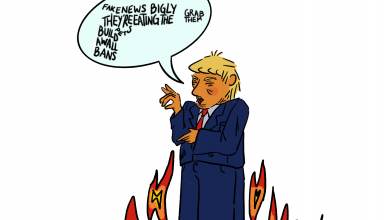Should California Abolish The Three-Strikes Law?
Image description: A photograph of a pair of hands grasping the bars of a jail cell.
In 1994, California adopted the Three Strikes Law, which requires a “twenty-five years to life [sentence] for people convicted of a third felony…[after already being convicted of] two serious or violent felonies.” This law was part of the U.S.’s “tough on crime” movement that was created in response to rising rates of violent crime and “aimed to indefinitely imprison habitual offenders.”
Despite aims to reduce crime, there is no evidence that the Three Strikes Law has reduced crime or recidivism (the likelihood of a criminal reoffending) rates in California. Additionally, according to Mike Romano, director of the Three Strikes Project at Stanford Law School, instead of locking up violent offenders, the law has “targeted crimes of poverty,” which are crimes that people commit because of their poor socioeconomic conditions and can be considered crimes of necessity. The law also targets low-level crimes where little harm has occurred, such as “small-time robbery [and] burglary.”
The law has also been criticized for disproportionately impacting Black and Latino populations and significantly increasing California’s prison population. An annual report released in December 2021 by the California Committee on the Revision of the Penal Code found that “80 percent of people sentenced under the three strikes law are people of color” and that more than 33,000 people are currently serving three-strikes sentences in California prisons. Thus, the committee has recommended the repeal of the Three Strikes Law.
Other critics directed their attention to the fact that juveniles who commit both violent and non-violent crimes can be given a strike, which can be later applied to their sentencing as adults. This does not allow youth offenders to be effectively rehabilitated as their criminal activities stay with them for the rest of their lives. Thus, critics argue that the Three Strikes Law focuses too much on imprisonment and incapacitation and “undermines the rehabilitative goals of the juvenile justice system.” Furthermore, they claim that the policy “disproportionately affects youth offenders of color and fails to consider their brain maturity.”
Since research has shown that minors who commit crimes are influenced by their peers and the environment they grow up in, the criminal justice system should provide services that rehabilitate juveniles and offer them a second chance at life by providing them with the appropriate social support and services. Instead, the Three Strikes Law keeps juvenile offenders tied to the system by keeping the strike on their permanent record.
When considering arguments against the Three Strikes Law, understanding the law’s economic implications is also essential. Taxpayers spend more than $100,000 a year to incarcerate an individual in California, and this cost becomes higher as those imprisoned grow older and have greater healthcare needs. Thus, it currently costs at least $3.3 billion per year to imprison those serving sentences under the Three Strikes Law.
For these reasons, many criminal justice advocates argue that the Three Strikes Law must be extensively reformed or even eliminated. One potential reform, Assembly Bill 1127, was proposed by Los Angeles Assemblymember Miguel Santiago in February 2021. This bill would have prohibited juvenile verdicts from being counted as strikes and given those serving a three-strike sentence with a juvenile verdict a chance at resentencing, which would have led to a decrease in California’s prison population. However, it did not get passed, emphasizing the punitive status quo of the Three Strikes Law.
Opponents of this bill, such as Elk Grove Assemblymember Jim Cooper, claimed that the bill “fails to consider victims [of crime],” a common talking point of law enforcement officials and prosecutors, and that there are other rehabilitative programs that could be enacted to reduce recidivism. Additionally, the California District Attorneys Association asserted that the bill’s retroactivity “would strip from judges and prosecutors the flexibility to apply or remove a strike,” essentially claiming that the bill goes against the established rules of the legal system and the authority the system assigns to judges and prosecutors.
Building on Assembly Bill 1127, Los Angeles District Attorney George Gascon advocated for the California Supreme Court to give him the authority “to bar his prosecutors from seeking harsher punishment for repeat offenders.” Thus, Gascon supported the elimination of the Three Strikes Law for both juvenile and adult offenders. Drawing on past research, Gascon saw these strikes as ineffective in deterring crime and unconstitutional due to the unfair imprisonment of Black and Latino individuals as well as low-level offenders.
The Los Angeles Supreme Court, however, maintained that the Three Strikes Law gave prosecutors the “duty to prescribe more severe punishment for certain recidivists,” and ignored the effects that the law has had on society, such as disproportionately incarcerating Black and Latino people and unfairly imprisoning those who have committed low-level crimes. The Court argued that giving Gascon the power to direct his deputies to not charge individuals with strikes and not follow the sentencing requirements of the Three Strikes Law would be an “overstate[ment of] his authority.” Instead, the Court stated that any changes to the law must be made and supported by California’s voters and legislature.
While those who oppose reforms to and the elimination of the Three Strikes Law argue that they are working in the best interests of crime victims, some support reforming the law after witnessing its harsh consequences. The Three Strikes Law was created in response to the growing fear of crime, more specifically in response to the kidnapping and murder of a 12-year-old girl named Polly Klaas in California in 1994 by an offender with an extensive criminal record. While it was initially supported by Polly’s father, its unjust consequences have caused Polly’s family to rethink their connection to the law.
As they got older, Polly’s two sisters, Annie and Jess, became uncomfortable with how Polly’s death and the subsequent development of the Three Strikes Law contributed to the issue of mass incarceration and racial inequality in the U.S. criminal justice system today. To them, “the story that was told about Polly was used to pass these incredibly terrible laws, and it always felt like a distortion of the truth.” Polly’s sisters felt that the prosecutors, lawmakers, media, and other upholders of the status quo in the criminal justice system took their sister’s story and claimed to represent it without asking the family what they wanted, which caused them to feel “disempowered” and “powerless.”
Furthermore, the sisters have described the law as “a symptom of systemic problems” and have advocated for an alternative, more rehabilitative approach to justice that seeks to resolve the root social causes of crime. Specifically, they desire a system that both fairly compensates victims and survivors for their losses and provides prevention services to communities to de-incentivize crime from occurring in the first place. They recommend that the U.S. government reallocates the money it spends on police and prisons toward “community resources, including violence prevention, mental health care, restorative justice, and services for survivors.”
This idea of rehabilitative practices as alternatives to incarceration originates from the prison abolition movement, which began in the U.S. in the 1980s in response to the War on Drugs and was spearheaded by the Black community. Early leaders of the prison abolition movement held similar views to current critics of the Three Strikes Law. They argued that many non-violent offenders were being sent to prison and that punitive policies disproportionately impacted low-income, Black, and Latino communities. For these reasons, prison abolitionists in the 1980s and critics of the Three Strikes Law today want to “reform the criminal justice system and offer alternatives to incarceration.”
The story of Polly’s family opposing the Three Strikes Law, as well as arguments made by political officials and other criminal justice reform activists about the negative economic and social consequences of the law, suggest that the law should be amended and/or replaced by a more rehabilitative approach toward crime. Criminal justice reformers should continue advocating on the behalf of poor people and people of color disproportionately impacted by the Three Strikes Law and work with victim advocacy programs to determine the best way to change the law and to establish an effective alternative for reducing crime.




